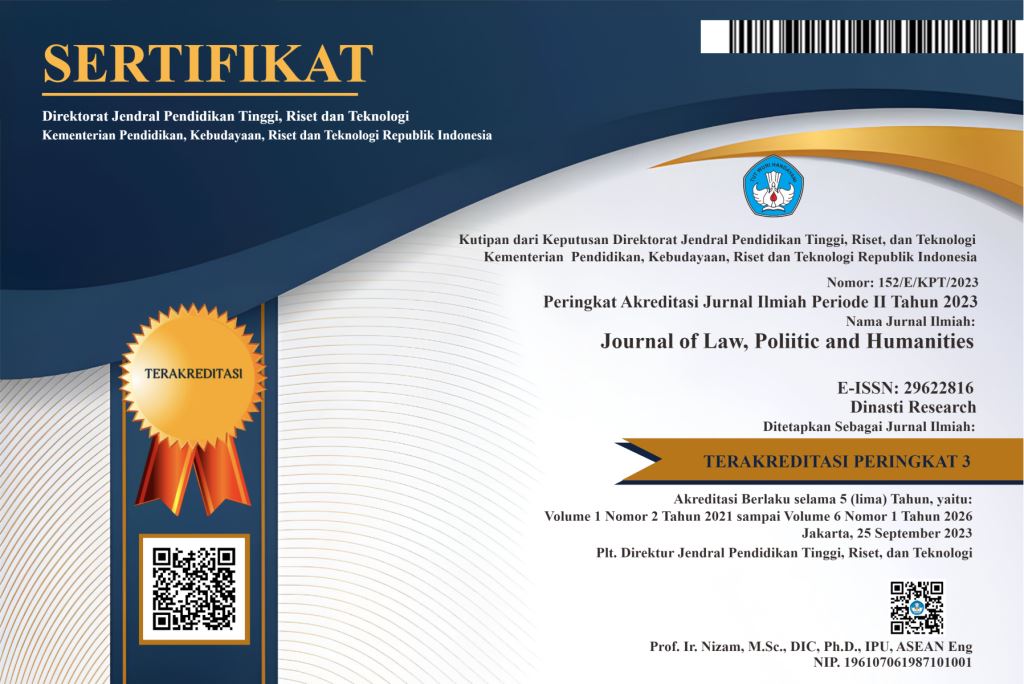Legal - Political Analysis of Indigenous Relocation in Rempang : Between Agrarian Justice and the Shadow of Colonial Land Doctrine. (Study Of Land Tenure Conflict Between The Community And BP Batam)
DOI:
https://doi.org/10.38035/jlph.v5i6.2326Keywords:
Forced relocation, Kampung Tua Rempang, Domein Verklaring, BP Batam, agrarian conflictAbstract
The agrarian conflict in Rempang Island emerged due to the planned relocation of the indigenous Kampung Tua Rempang community by the Batam Development Authority (BP Batam) for development of Rempang Eco City, designated as National Strategic Project (PSN). The community rejected relocation, arguing that they have inhabited the land for generations prior to the establishment of the Batam Authority, despite lacking formal land ownership certificates. This study aims to : analyze the government's legal policy regarding relocation and assess whether the Rempang case reflects the colonial-era principle of Domein Verklaring, which treats land without proof of ownership as state property. This research uses a normative juridical approach, focusing on analysis of laws and regulations such as Basic Agrarian Law (UUPA) No. 5 of 1960, Presidential Decree No. 41 of 1973, Presidential Decree No. 28 of 1992, and Government Regulation No. 18 of 2021. The findings reveal that BP Batam lacks legal standing, as Land Management Rights (HPL) certificate for Rempang has not been issued, and legal requirements such as compensation, community consultation, and relocation have not been fulfilled. This relocation practice closely resembles Domein Verklaring and represents form of modern agrarian colonialism that contradicts principles of justice in Indonesia’s agrarian law.
References
Arman, D. (2023,September 17). The History of Rempang Island Revealed by BRIN Researcher: Malay Galang, Inland People, and Sea People Are the Indigenous Ethnic Groups of Rempang Island. tvonenews.com. https://www.tvonenews.com/daerah/sumatera/153134-sejarah-pulau-rempang-diungkap-peneliti-brin-melayu-galang-orang-darat-dan-orang-laut-adalah-suku-asli-pulau-rempang
Budi Harsono. (1997).Indonesian agrarian law: History of the formation of the Basic Agrarian Law, its contents and implementation (7th ed.). Djambatan.
CNN Indonesia. (2023, September 15). BP Batam: New residential facilities for Rempang residents will be complete.https://www.cnnindonesia.com
Eka Sahputra, Y. (2023, September 16).Indigenous people in Rempang, existed before Indonesia. Mongabay.https://www.mongabay.co.id
Harsono, B. (1997).Indonesian agrarian law: History of the formation of the Basic Agrarian Law, its contents and implementation. Bridge.
Ministry of Agrarian Affairs and Spatial Planning/National Land Agency. (1993).Regulation of the Minister of Agrarian Affairs Number 9-VIII of 1993 concerning the Willingness to Transfer Land Management Rights on Rempang and Galang Islands to the Batam Authority.
Ministry of ATR/BPN. (2021).Government Regulation Number 18 of 2021 concerning Management Rights, Land Rights, Apartment Units, and Land Registration. Ministry of Internal Affairs. (1974). Decree of the Minister of Home Affairs Number 77 of 1974 concerning Procedures for Providing Compensation for Land, Plants, and Buildings in the Batam Authority Area.
Coordinating Ministry for Economic Affairs. (2023).Regulation of the Coordinating Minister for Economic Affairs Number 7 of 2023 concerning the List of National Strategic Projects.
Kompas. (2023, September 12).BP Batam promises to build type 45 houses for Rempang residents. https://www.kompas.com
Mahfud MD. (2011).Legal politics in Indonesia(4th Edition). Rajawali Press. Marzuki, PM (2010).Legal research. Golden.
Regulation of the Minister of Agrarian Affairs. (1965).Regulation of the Minister of Agrarian Affairs Number 9 of 1965 concerning the Implementation of Conversion of Control over State Land and Provisions concerning Policies.
Rato, S. (2016).Indonesian customary law: Existence in the national legal system. LaksBang Pressindo.
Rahardjo, S. (2006).Progressive law: Law that liberates. Compass.
Republic of Indonesia. (1960).Law Number 5 of 1960 concerning Basic Agrarian Regulations (UUPA).
Republic of Indonesia. (1973).Presidential Decree Number 41 of 1973 concerning the Batam Island Industrial Area.
Republic of Indonesia. (1992).Presidential Decree Number 28 of 1992 concerning the Addition of the Working Area of the Batam Island Industrial Area and its Determination as a Bonded Zone Business Area.
Republic of Indonesia. (2007).Government Regulation Number 46 of 2007 concerning the Batam Free Trade Area and Free Port.
Republic of Indonesia. (2021).Government Regulation Number 18 of 2021 concerning Management Rights, Land Rights, Apartment Units, and Land Registration.
Soemardjan, S. (2009).Conflict and social integration. LP3ES.
Tempo. (2023, September 14).Rempang residents demand fulfillment of the President's promise of land certificates. https://www.tempo.co
Tempo.co. (2023, September 18).Minister of ATR: BP Batam's HPL on Rempang Island is still in the measurement process.https://nasional.tempo.co/read/1763649/menteri-atr-hpl-bp-batam-di-pulau- rempang-masih-dalam-proses-pengukuran
Thontowi, J. (2008).Law and society. Gadjah Mada University Press.
Thontowi, J. (2008).Cultural anthropological research on human resource development in the border development center in Saajingan Besar District, Sambas Regency. CLDS FH UII and Bappeda Sambas Regency.
Wignjodipuro, S. (1973).Introduction and principles of customary law. Mount Agung.
Downloads
Published
How to Cite
Issue
Section
License
Copyright (c) 2025 Ilham Mustafa, Suhadi, Irawaty

This work is licensed under a Creative Commons Attribution 4.0 International License.
Authors who publish their manuscripts in this journal agree to the following conditions:
- The copyright on each article belongs to the author(s).
- The author acknowledges that the Journal of Law, Poliitic and Humanities (JLPH) has the right to be the first to publish with a Creative Commons Attribution 4.0 International license (Attribution 4.0 International (CC BY 4.0).
- Authors can submit articles separately, arrange for the non-exclusive distribution of manuscripts that have been published in this journal into other versions (e.g., sent to the author's institutional repository, publication into books, etc.), by acknowledging that the manuscript has been published for the first time in the Journal of Law, Poliitic and Humanities (JLPH).


























